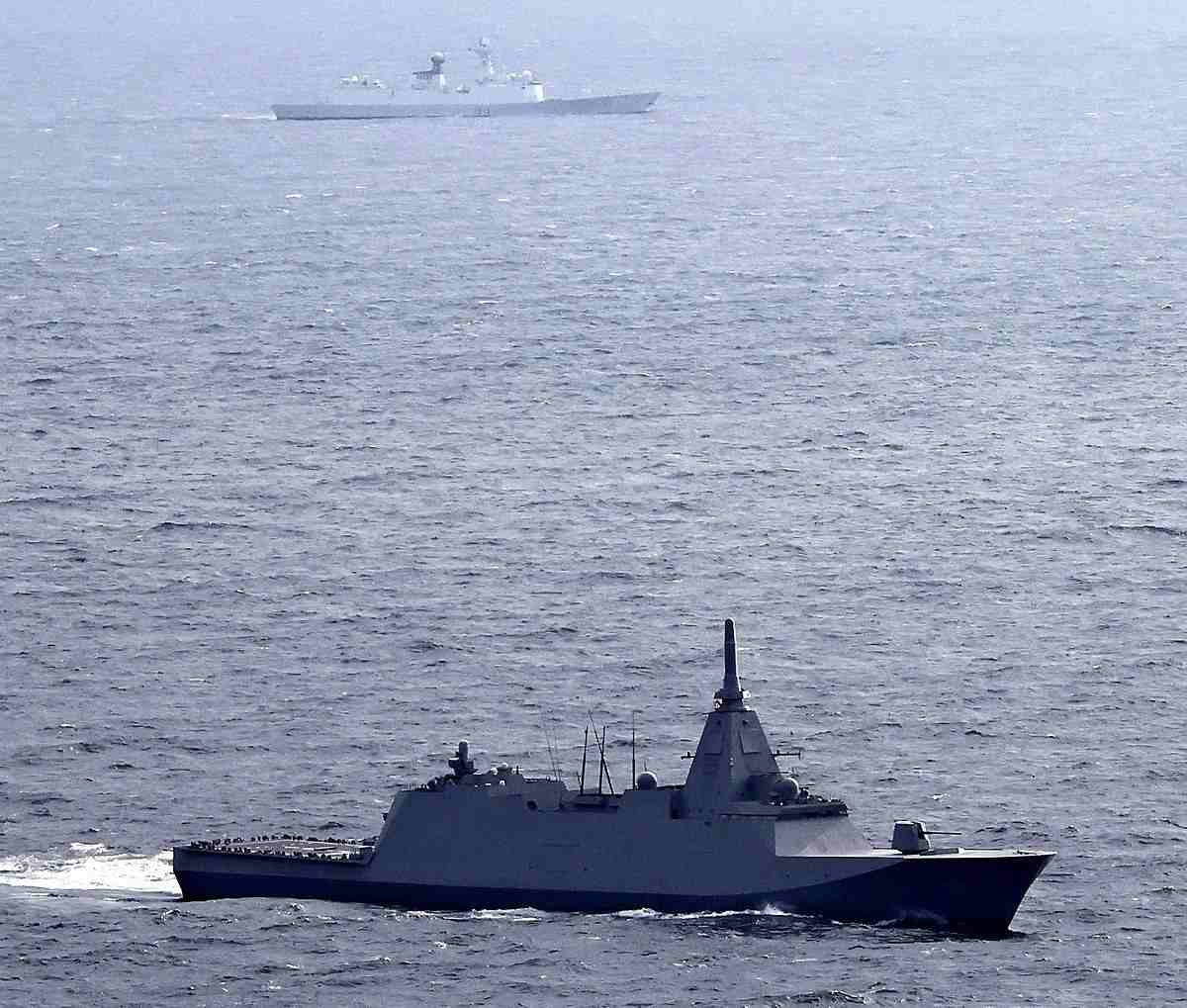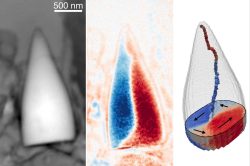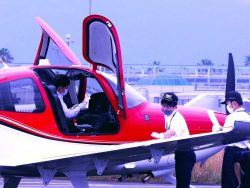
A Jiangkai II-class guided-missile frigate of the Chinese Navy, rear, is seen near the Maritime Self-Defense Force destroyer JS Mikuma on Dec. 30.
21:00 JST, January 28, 2024
China is deploying multiple warships around the clock in waters near the borders of the air defense identification zone that it has unilaterally established, The Yomiuri Shimbun has learned.
A photograph taken by a Yomiuri Shimbun journalist on Dec. 30 showed a Jiangkai II-class guided-missile frigate of the Chinese Navy in the zone.
Air defense identification zones, or ADIZs, are set up by individual countries outside their territorial airspace to prevent incursions. Countries decide whether there is a possibility of their airspace being entered, and whether their fighter aircraft should scramble. Just passing through Japan’s ADIZ does not result in the scrambling of Self-Defense Forces planes.
China is operating the zone on the premise that it is Chinese airspace. Aircraft that fly within its ADIZ are told to immediately leave.
China’s move shows that it is a pressing issue for the Japanese government to take action to deal with Beijing’s attempt to change the status quo by force. China’s ADIZ, established in November 2013, overlaps with Japan’s and includes the Senkaku Islands, over which China claims sovereignty.

Contrary to international custom, China unilaterally demands that aircraft flying in the zone follow Chinese authorities’ instructions. It also claims it will take “defensive emergency measures” if an aircraft fails to do so.
China is thought to be claiming jurisdiction that is not based in international law. The Japanese government is strongly opposed, calling China’s actions invalid, and the United States and South Korea have also expressed concern.
The Yomiuri journalist photographed the Chinese Jiangkai II-class guided-missile frigate and the Maritime Self-Defense Force’s newly commissioned frigate JS Mikuma facing each other in waters about 20 kilometers inside the border of what China insists is its ADIZ.
During the flight, the Yomiuri also confirmed a radio communication in which the Chinese Navy warship called on a separate aircraft flying within China’s ADIZ to leave the airspace.
China started deploying at least three navy warships around the clock in waters around its claimed ADIZ, according to Japanese government sources.
The three include an air defense missile destroyer, which is the Chinese version of an Aegis-equipped destroyer, and a frigate warship. Equipped with high-performance radar, air defense missile destroyers are highly capable of shooting down aircraft.
The Chinese military aircraft repeatedly scramble in response to SDF aircraft, according to the sources. The Chinese military is believed to be strengthening its monitoring of SDF and U.S. military aircraft and warships in the East China Sea.
To effectively establish ADIZs, it is essential to deploy radar that can detect early on the approach of other countries’ aircraft, and improve the efficiency of fighter units so they can immediately reach the spot.
China’s monitoring capabilities were initially believed to be low, and it was thought that its establishment of the ADIZ would have no substantial impact.
However, some observers are warning that China will have its warships, which are deployed around the clock, and fighters work together and increase its military activities.
“It’s intended to block the SDF and U.S. military aircraft [from entering the airspace] in the event of contingencies in the Taiwan Strait,” said an SDF source.
Japanese government sources believe that the Chinese warships’ 24-hour deployment in the area is linked with China’s claim of sovereignty over the Senkaku Islands. In fact, when China Coast Guard vessels operating around the Senkakus intruded into Japanese territorial waters, the warships deployed in the area moved southward.
“When China established the ADIZ 10 years ago, it was meant more as a message to keep Japan and the U.S. in check,” said Yasuyuki Sugiura, a senior fellow of the Regional Studies Department’s China Division at the National Institute for Defense Studies.
“In recent years, however, the Chinese air force and navy are increasingly sharing their information. This must mean their capabilities have become more substantial,” he said.
"Politics" POPULAR ARTICLE
-

Japan to Charge Foreigners More for Residence Permits, Looking to Align with Western Countries
-

China Would Cut Off Takaichi’s ‘Filthy Head’ in Taiwan Crisis, Diplomat Allegedly Says in Online Post
-

If China Were to Impose Blockade on Taiwan, Existential Crisis Could Be Triggered, Japan’s Prime Minister Takaichi Says
-

Japan to Tighten Screening of Foreigners’ Residential Status by Providing Information of Nonpayment of Taxes
-

Takaichi Cabinet Approval Holds at 72% as Voters Back Aggressive Fiscal Stimulus, Child Benefits
JN ACCESS RANKING
-

Govt Plans to Urge Municipalities to Help Residents Cope with Rising Prices
-

Japan Resumes Scallop Exports to China
-

Japan Prime Minister Takaichi Vows to Have Country Exit Deflation, Closely Monitor Economic Indicators
-

Japan to Charge Foreigners More for Residence Permits, Looking to Align with Western Countries
-

Japan GDP Down Annualized 1.8% in July-Sept.

























